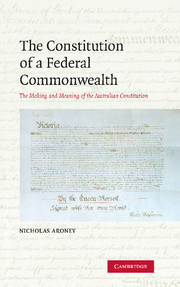Book contents
- Frontmatter
- Contents
- Preface
- Table of statutes and executive instruments
- Table of cases
- Introduction: Australia as a federal commonwealth
- PART I Federalism
- PART II Federating Australia
- 3 Models and sources
- 4 Australian appropriations
- 5 Constitutional foundations
- 6 Formative institutions
- PART III Australian federation
- PART IV Conclusions
- Select provisions
- Bibliography
- Index
3 - Models and sources
Published online by Cambridge University Press: 05 August 2012
- Frontmatter
- Contents
- Preface
- Table of statutes and executive instruments
- Table of cases
- Introduction: Australia as a federal commonwealth
- PART I Federalism
- PART II Federating Australia
- 3 Models and sources
- 4 Australian appropriations
- 5 Constitutional foundations
- 6 Formative institutions
- PART III Australian federation
- PART IV Conclusions
- Select provisions
- Bibliography
- Index
Summary
What makes the Union between any States Federal is not the manner of its action, but the Fœdus, the Covenant, the Convention, the Compact upon which it is founded!
Alexander Stephens (1868)When the political leaders of the Australian colonies turned their minds to nation-building in the latter half of the nineteenth century, there was little doubt that a union of the colonies would have to be federal in form. The reasons for this were both practical and philosophical.
On the practical side, the colonies had enjoyed the benefits of local self-government and representative institutions since the 1850s. Having recently acquired such powers, local politicians and voters were not about to acquiesce in the loss of those rights to a consolidated national government. Samuel Griffith, then premier of the colony of Queensland, observed that the Australian colonies had been ‘accustomed for so long to self-government’ that they had ‘become practically almost sovereign states, a great deal more sovereign states, though not in name, than the separate States of America’. Josiah Symon, a prominent South Australian delegate to the federal convention of 1897‘8, similarly asserted: ‘We all represent what are really sovereign states – sovereign states in essence, if not in form.’
In this context, the formation of a unitary nation-state was neither possible nor thinkable. As Griffith put it, the ‘essential’ and ‘preliminary’ condition of federation would be that:
the separate states are to continue as autonomous bodies, surrendering only so much of their powers as is necessary to the establishment of a general government to do for them collectively what they cannot do individually for themselves, and which they cannot do as a collective body for themselves.
- Type
- Chapter
- Information
- The Constitution of a Federal CommonwealthThe Making and Meaning of the Australian Constitution, pp. 67 - 100Publisher: Cambridge University PressPrint publication year: 2009



